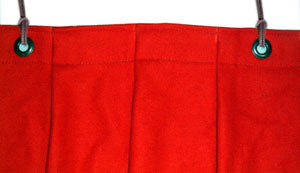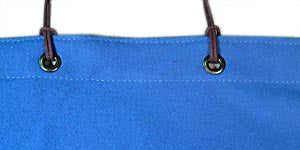Curtains
Types of Stage Curtains
Front-of-House curtain (main curtain) is the visual and sound barrier between the audience and the stage. The most common type of main curtain is a bi-parting curtain i.e. a pair of curtains that overlap and split at the centre of the stage, and open to the sides. The main curtain is usually manufactured from heavy weight IFR velvet or IFR wool.
Valance curtain is a horizontal masking curtain usually made from the same material as the front-of-house and is suspended on a batten in front of the main curtain. Masking curtains are used to hide the off-stage areas, divide the stage, and provide access to the main stage area.
Masking curtains include Borders, Tabs and Legs (wing curtains) They are used to hide actors, off stage areas, lighting bars, curtain tracks and sets.
Backdrop curtains are usually manufactured from a seamless cotton fabric and they provide a scenic element to the stage. The seamless cotton is available in widths of up to 10 metres and is suitable for painting.
Floor cloths can be manufactured in seamless 6 oz canvas or a heavy-duty 12 oz canvas with seams.
Cycloramas are backdrops at the rear of the stage and are used primarily for lighting and projection purposes. They are generally manufactured from a white seamless Filled Cloth or white Nessel canvas
Gauzes are open weave fabrics that when lit from the front (and the stage behind the gauze is totally dark), the gauze appears opaque and renders the scene behind the gauze invisible. When the scene behind the gauze is illuminated and the front lights on the gauze are dimmed, the gauze becomes invisible, revealing the upstage scene. The most common type of gauze used in Australia is called sharkstooth gauze
Projection screens are manufactured from a lightweight, fire-resistant vinyl fabric and can be made to your specific requirements.
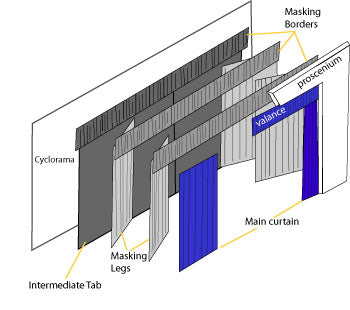
Sound Absorption Curtains
Sound Absorption Curtains or acoustic drapes are used in rooms or venues where sound absorption is required. Put simply, sound absorption curtains absorb echo within a room, and therefore improve the sound quality within the space.
- Please note: Sound absorption curtains are not used for sound proofing i.e. block or stopping sound travelling from one space into another adjacent space.
Factors that affect sound absorption curtains
- Fabric thickness- Sound absorption curtain material should be thick and fibrous. We recommend using a wool serge fabric that is a minimum of 500 GSM
- Pleating- Sound absorption curtains that are pleated have a larger surface area available to absorb the sound waves. The minimum amount of pleating required is 50% fullness, but 100% fullness is recommended.
- Air Gap- Sound absorption curtains function more efficiently if they are spaced away from the surface behind them (50mm-100mm). An air gap increases the sound absorptive properties of the curtain in the mid and higher frequency range
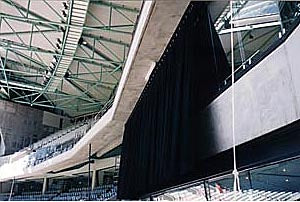
Stage Curtain Finish
Top Finish
The top of the curtain is reinforced with heavy duty webbing made from cotton herringbone, jute or polyester. It is standard to use eyelets and cotton cord ties (A) to hang the curtains. For heavy duty applications, cotton webbing can be used in conjunction with eyelets and metal snap hooks (B).
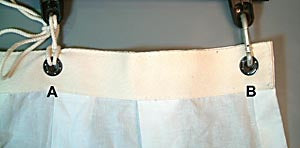
Side Finish
A 50 mm double hem is standard for our curtains.
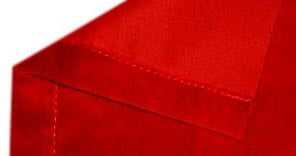
Leading Edge
The leading edge of a bi-parting curtain, particularly a main curtain, can have a portion of the face fabric turned back. This prevents the audience from seeing the rear of the curtain when in movement or during paging. Standard face back is 200 mm for main curtains and 50-100 mm for tab curtains.
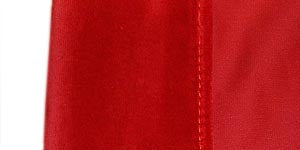
Bottom Finish
For stage curtains with fullness, it is standard to finish with a 100 mm-150 mm base chain pocket. This pocket is reinforced with canvas and has Velcro tabs to secure the chain.
- For stage curtains without fullness it is standard to finish with a 100 mm base hem. The base hem remains open at the sides for easy insertion of a pipe.
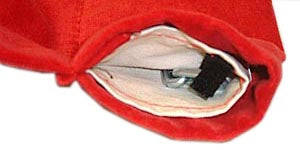
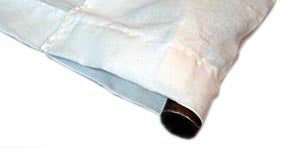
Fullness
Fullness is additional fabric sewn into a stage curtain by means of pleats.
- 100% fullness indicates the curtain has been manufactured with twice as much fabric as the finished width.
- 50% fullness indicates the curtain has been manufactured from 1 1/2 times as much fabric as the finished width
- 0% Fullness indicates that the curtain is completely flat, i.e. no pleats.

